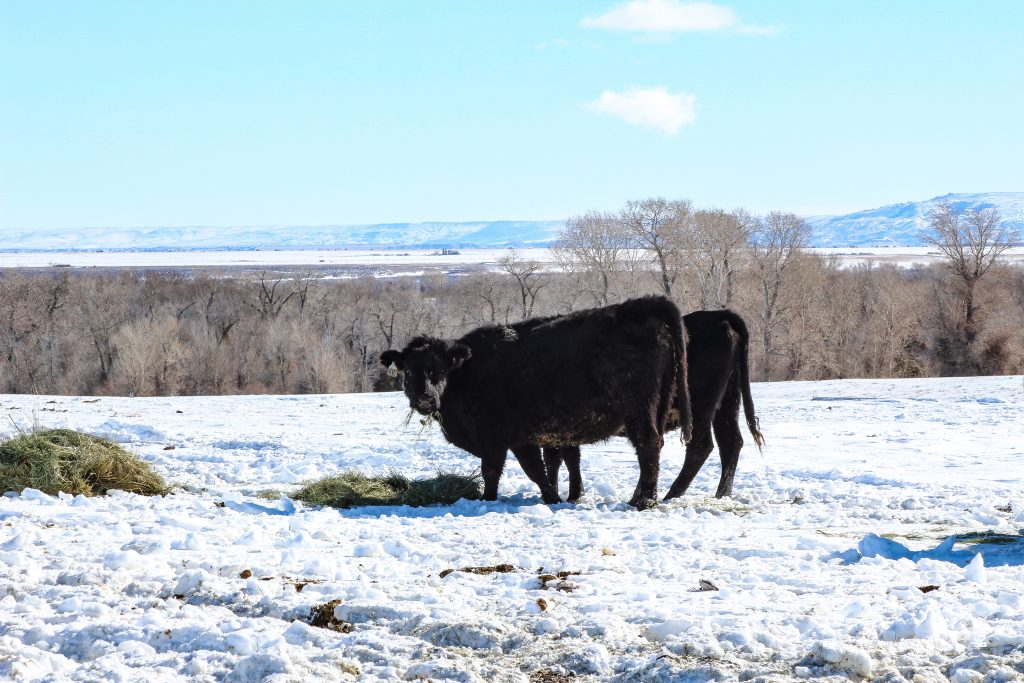Surviving Winter Chill: Feeding management practices can help cattle battle cold stress

“Cold stress, defined as a lower critical temperature, is the temperature below which a resting animal must increase its metabolic rate to stay warm. The actual air temperature when this occurs varies, depending in large part, on the amount of insulation an animal has. Thickness of the hair coat and whether the hair is dry, wet and/or matted are major influencers,” explains Bill Halfman, University of Wisconsin-Madison Extension beef outreach specialist, in a Farm Progress article published Dec. 1.
With winter well under way in the West, are facing snowy, windy weather, and cowherds are battling cold stress. Halfman offers advice on specific feeding management practices to help cattle handle cold stress.
Cold stress
According to Halfman, the critical lower temperature for cattle with a wet or summer coat is 59 degrees Fahrenheit, and the critical lower temperature for cattle with a dry, fall coat is 45 degrees Fahrenheit.
Additionally, cattle with a dry, winter coat have a lower critical temperature of 32 degrees Fahrenheit, and cattle with a dry, heavy, winter coat have a lower critical temperature of 18 degrees Fahrenheit.
These numbers assume no wind chill. However, Halfman points out it is critical to include wind chill when calculating how many degrees below a cow’s critical temperature it is, in order to estimate the severity of cold stress.
Halfman explains an example of this is a winter day of 20 degrees Fahrenheit with 10 mile per hour winds has the same effect on cattle as a nine-degree day with no wind.
“Conditions where cattle have wet hides or can’t get out of the wind result in cold stress,” he says.
Energy requirements
When temperatures drop below lower critical temperature, Halfman says cattle will usually voluntarily consume more feed to meet the added energy requirements they need to stay warm, which can range anywhere from a two to 25 percent increase in feed intake.
He further explains extreme cold temperatures, blizzards, barometric pressure changes and lack of shelter influence intake as well.
“Energy needs of cattle increase about one percent for every one degree Fahrenheit below the lower critical temperature,” Halfman explains. “Knowing forage quality is critical to knowing what options there are for providing the extra needed energy to help cattle deal with cold stress.”
In fact, a forage’s neutral detergent fiber (NDF), structural components of a plant that provide bulk or fill, plays a huge role in determining how much a cow will eat. Halfman notes, in general, a cow can eat 1.1 percent of her body weight of NDF, but this depends on the digestibility of the fiber.
With this said, energy needs of the herd may not be met during a cold stress event if they are fed low-quality forage during this time, according to Halfman.
Feeding management recommendations
To combat this and help cattle meet higher energy requirements needed to deal with cold stress, Halfman recommends supplementing cattle with extra corn or other high-energy feedstuffs when temperatures drop below lower critical temperatures.
“Some beef producers can provide extra energy needs by feeding higher-quality forages during colder weather,” he says. “Knowing the quality analysis of available feed resources helps economically and efficiently match resources to the needs of individual situations.”
Regardless of the supplement used, Halfman notes it is important to prevent pushy cows from eating most of the supplement and timid cows from not getting any by ensuring all animals have access to supplemented feed.
He suggests providing at least 30 inches of bunk space per head or dividing cattle into smaller groups based on age, weight and body condition score to avoid competition.
“Remember cattle can adapt to short-term weather changes relatively well without significant impacts on performance,” he says. “Cows in good winter condition with dry, clean hair coats and wind shelter can deal with a few cold, miserable days without suffering any long-term effects.”
“However, ignoring the energy costs of long-term cold stress greatly increases the risk of problems down the road during calving and subsequent rebreeding performance,” he concludes.
Hannah Bugas is the managing editor of the Wyoming Livestock Roundup. Send comments on this article to roundup@wylr.net.





